Cane Sugar Processing: Traditional Techniques and Modern Innovations
Cane Sugar Processing: Traditional Techniques and Modern Innovations
Blog Article
Discovering the Comprehensive Tips Entailed in Walking Cane Sugar Handling From Gathering to Improvement
The process of walking stick sugar production incorporates a collection of elaborate actions, beginning with the mindful harvesting of sugarcane and culminating in the refinement phases that guarantee the final item satisfies market requirements. Each stage, from the extraction of juice to the purification and formation processes, plays a crucial duty in figuring out the quality and character of the sugar.
Collecting Sugarcane
Harvesting sugarcane is a crucial step in the walking stick sugar processing chain, as it directly influences the quality and yield of the end product. Appropriate timing and methods are essential during this phase to ensure optimal sugar content and minimize losses. Typically, sugarcane is harvested when it gets to maturation, generally 12 to 18 months after growing, characterized by a high sucrose focus.

Post-harvest, the sugarcane has to be processed swiftly to avoid sucrose deterioration. Ideally, harvested walking stick ought to be transferred to processing centers within 24 hours to maintain sugar top quality. Consequently, reliable logistical planning is crucial to preserve the stability of the collected plant throughout the supply chain.
Extraction Refine

The crushed walking stick goes through a series of pressing operations to make the most of juice healing. Usually, warm water is splashed onto the smashed cane, producing a countercurrent flow that aids liquify the sugar while additionally aiding in the removal procedure. The juice collected from this operation has not just sugar yet additionally various organic compounds and contaminations.

To boost extraction efficiency, some centers may utilize diffusion methods, where the sugarcane is saturated in warm water, allowing the soluble sugars to diffuse right into the liquid. The resulting juice, abundant in sucrose, is then directed to succeeding handling stages, laying the structure for purification and refinement. The removal process is hence essential in establishing the top quality and return of the final sugar item.
Filtration Methods
The purification techniques used in walking stick sugar handling are necessary for transforming the raw juice right into a premium sugar item. These techniques largely intend to remove pollutants, such as dirt, plant materials, and not natural substances, which can negatively influence the end product's taste and shade.
This procedure entails adding lime and warm to the raw juice, which promotes the coagulation of contaminations. Additionally, the use of phosphoric acid can improve the explanation procedure by more binding impurities.
Another considerable method is click to read more carbonatation, where co2 is presented to the cleared up juice. This response creates calcium carbonate, which records continuing to be contaminations and advertises their elimination.
Furthermore, activated carbon treatment might be related to adsorb any kind of continuing to be colorants and natural contaminations, ensuring a find out here now much more refined product. The combination of these techniques successfully prepares the sugar juice for succeeding action in the refining process, setting the stage for the production of premium walking cane sugar.
Formation Methods
After the purification phase, the next important action in cane sugar processing includes condensation techniques, which play a pivotal role in transforming the clarified juice into solid sugar. This procedure generally employs 2 key techniques: spontaneous condensation and controlled crystallization.
In spontaneous formation, supersaturated sugar remedies are permitted to cool down naturally, causing the formation of sugar crystals with time. This method is simpler but might lead to uneven crystal sizes and reduced pureness levels. On the various other hand, managed crystallization is an extra exact technique where temperature level, seeding, and concentration agents are carefully taken care of. This method permits the consistent growth of sugar crystals and higher pureness.
Throughout condensation, the made clear juice is concentrated with dissipation, increasing its sugar material till it reaches supersaturation. When this factor is accomplished, either method can promote the crystallization procedure. Cane Sugar Processing. The resultant sugar crystals are then divided from the continuing to be syrup with centrifugation
Inevitably, the selection of condensation approach affects the quality, size, and pureness of the final sugar item, making this action crucial in the general walking stick sugar handling treatment.
Refinement and Packaging
Just how Continue can the pureness and high quality of cane sugar be even more enhanced after formation? The improvement procedure plays a critical duty in attaining high-grade walking stick sugar.
Following, the sugar goes through a process called centrifugation, where it is rotated at broadband to separate the detoxified sugar crystals from the staying liquid. After centrifugation, the sugar is often more fine-tuned through a method called carbonization or phosphatation, which makes use of triggered carbon or phosphoric acid to eliminate shade and off-flavors.
Once improved, the sugar is dried to achieve the wanted wetness content, making certain that it stays secure throughout storage and transport. The final action includes product packaging the polished sugar in moisture-proof and closed containers to keep its top quality and stop contamination. Cane Sugar Processing. Appropriate packaging not just prolongs service life but additionally promotes simple handling and distribution, guaranteeing that consumers obtain sugar that meets the highest criteria of purity and high quality
Final Thought
The thorough steps entailed in cane sugar handling, from the thorough harvesting of sugarcane to the elaborate refinement and product packaging phases, emphasize the importance of each phase in making certain top quality sugar manufacturing. Optimum harvesting techniques, effective extraction methods, and rigorous purification processes collectively add to the end product's pureness and security. The condensation and succeeding product packaging methods better boost the honesty and rack life of the sugar, highlighting the intricacy and accuracy inherent in this necessary farming market.
The procedure of walking stick sugar production includes a series of intricate steps, starting with the mindful harvesting of sugarcane and finishing in the refinement stages that ensure the last item fulfills market requirements. Ideally, harvested cane should be transferred to processing facilities within 24 hours to maintain sugar top quality.In spontaneous formation, supersaturated sugar options are enabled to cool down normally, leading to the formation of sugar crystals over time - Cane Sugar Processing. The refinement procedure plays a vital role in achieving premium walking stick sugar.The detailed steps involved in cane sugar handling, from the thorough harvesting of sugarcane to the detailed refinement and packaging stages, underscore the importance of each phase in ensuring high-quality sugar manufacturing
Report this page